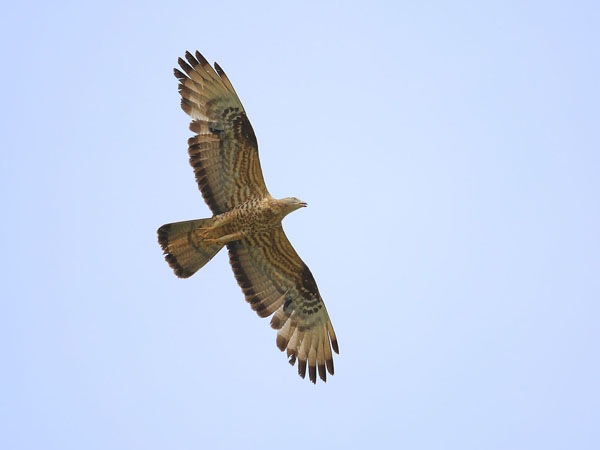Pernis apivorus
IUCN
LCBasic Information
Scientific classification
- name:Pernis apivorus
- Scientific Name:European Honey Buzzard、Western Honey-Buzzard
- Outline:Raptor
- Family:Accipitriformes Accipitridae Pernis
Vital signs
- length:52-60cm
- Weight:600-1000g
- lifetime:29year
Feature
Have a strong visual memory of geographical features and can accurately locate the flight direction
Distribution and Habitat
In China, there are confirmed records in Yili, Xinjiang, and unconfirmed records in Kashgar, Xinjiang, Altai Mountains, etc. Abroad, it is distributed in Europe, western Asia, the Caucasus region of Russia, and winters in Africa south of the Sahara. When flying, the wings are flat, and the flying temperament appears to be stable. It inhabits broad-leaved forests, coniferous forests and mixed forests at different altitudes, especially sparse forests and forest edges. Sometimes it also moves in small forests such as villages outside the forest, farmlands and orchards. It usually moves alone, and occasionally gathers in small groups in winter. It is agile in flight, mostly flapping its wings. It often flaps its wings quickly to fly from one tree to another, and occasionally soars over the forest, or glides slowly, calling while flying, and the call is short, like a whistle. Sometimes it is also seen perched on the treetops of tall trees or on the branches at the bottom of the trees in the
Appearance
The body color is similar to that of the Crested Honey Buzzard, showing extremely diverse patterns, ranging from very white to very black. The female is slightly larger than the male. The head is small, blue-grey in the male, while the female has a brown head. The short, hard, scaly feathers on the sides of the head are thicker and denser, which is one of its unique characteristics. The back of the head usually has a short black crest, which makes it unique. The iris is golden yellow or orange-red, which is very beautiful. The bill is black, the feet and toes are yellow, and the claws are black. It is very similar to the Common Buzzard. When flying in the air, the wings rise smoothly and powerfully. It has a longer tail with two narrow dark stripes, and fewer stripes on the body than the kite.
Details
The Cuckoo-headed Honey Buzzard is a bird of the Accipitridae family and the genus Honey Buzzard. It is a medium-sized bird of prey, about 0.6 meters long, with dark brown feathers on its back. The face has small and dense feathers that look like scales. Honey Buzzards often live in sparse pine forests and often move around in rural fields and grasslands. Honey Buzzards dig up beehives and devour bee eggs, bee larvae and even adult bees with stingers. The dense feathers on their faces, like scales, act like helmets, making it difficult for bee colonies to do anything about them.
This species often moves its habitat with the bee colonies in summer. In winter, they return to warmer areas. Honey Buzzards not only eat bees, but also small animals such as katydids, stink bugs, mice, frogs and snakes. They are distributed in Europe and western Asia, from Spain, France, southeast England, Scandinavia, the Caucasus region of Russia to Siberia; in winter, they enter southern Sahara Africa.

The Cuckoo-headed Honey Buzzard is a migratory bird with a strong visual memory of geographical features (mountains, rivers, etc.) and magnetic orientation. This species is able to accurately locate the direction of flight and avoid large areas of water that interfere with the migration route when soaring at high altitudes. Therefore, the Cuckoo-headed Honey Buzzard can cross the narrowest areas, such as the Strait of Gibraltar, the Bosphorus, or fly over Israel and the Mediterranean Sea. The Honey Buzzard is considered to be adapted to a wider range of habitats, but generally prefers exotic woodlands and plantations.
Mainly feed on wasps, hornets, bees and other bees, and also eat other insects and insect larvae, and occasionally eat small snakes, lizards, frogs, small mammals, rodents, birds, bird eggs and young birds and other animal food. Usually hunt in flight, and can chase small birds such as finches. Most of them forage on trees in the forest or on the ground, often using their claws to dig honeycombs on the ground, just like chickens digging for food, pecking at various foods in the honeycomb, eating with relish.








